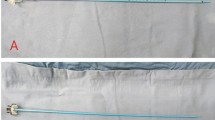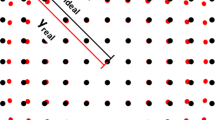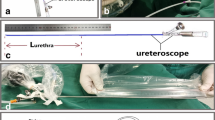Key Points
-
A ureteral access sheath (UAS) enables the urologist to repeatedly pass the ureteroscope into the upper ureter and kidney, without a need to pass the ureteroscope over a working wire
-
The ureteral access sheath (UAS) has a hydrophilic coating and is designed to be resistant to kinking and buckling during retrograde passage into the ureter
-
Use of a UAS improves the flow of irrigation fluid and visualization within the ureter, reduces operative times and overall costs and improves the effectiveness of surgery
-
Use of a UAS can cause injury to the ureter, might increase the risk of ureteral wall ischaemia, and, theoretically, carries an increased risk of ureteral strictures
-
To minimize the risk of postoperative complications, a ureteral stent is typically placed at the end of a procedure in which a UAS has been used
Abstract
The ureteral access sheath (UAS) facilitates the use of flexible ureteroscopy, enabling improved minimally invasive management of complex upper urinary tract diseases. The UAS, which comes in a variety of diameters and lengths, is passed in a retrograde fashion, aided by a hydrophilic coating and other features designed to confer smooth passage into the ureter with sufficient resistance to kinking and buckling. Use of a UAS has the advantage of enabling repeated passage of the ureteroscope while minimizing damage to the ureter, thus improving the flow of irrigation fluid and visualization within the urethra with reductions in operative times, which improves both the effectiveness of the surgery and reduces the costs. Placement of the UAS carries an increased risk of ureteral wall ischaemia and injury to the mucosal or muscular layers of the ureter, and a theoretically increased risk of ureteral strictures. A ureteral stent is typically placed after ureteroscopy with a UAS. Endourologists have found several additional practical uses of a UAS, such as the percutaneous treatment of patients with ureteral stones, and solutions to other endourological challenges.
This is a preview of subscription content, access via your institution
Access options
Subscribe to this journal
Receive 12 print issues and online access
$209.00 per year
only $17.42 per issue
Buy this article
- Purchase on Springer Link
- Instant access to full article PDF
Prices may be subject to local taxes which are calculated during checkout


Similar content being viewed by others
References
Monga, M. et al. Ureteral access for upper urinary tract disease: the access sheath. J. Endourol. 15, 831–834 (2001).
Takayasu, H. & Aso, Y. Recent development for pyeloureteroscopy: guide tube method for its introduction into the ureter. J. Urol. 112, 176–178 (1974).
Vanlangendonck, R. & Landman, J. Ureteral access strategies: pro-access sheath. Urol. Clin. North Am. 31, 71–81 (2004).
Kourambas, J., Byrne, R. R. & Preminger, G. M. Does a ureteral access sheath facilitate ureteroscopy? J. Urol. 165, 789–793 (2001).
Pietrow, P. K. et al. Techniques to maximize flexible ureteroscope longevity. Urology 60, 784–788 (2002).
Pedro, R. N., Hendlin, K., Durfee, W. K. & Monga M. Physical characteristics of next-generation ureteral access sheaths: buckling and kinking. Urology 70, 440–442 (2007).
Monga, M. et al. Prospective randomized comparison of 2 ureteral access sheaths during flexible retrograde ureteroscopy. J. Urol. 172, 572–573 (2004).
Shields, J. M., Tunuguntla, H. S., Bhalani, V. K., Ayyathurai, R. & Bird, V. G. Construction-related differences seen in ureteral access sheaths: comparison of reinforced versus nonreinforced ureteral access sheaths. Urology 73, 241–244 (2009).
Al-Qahtani, S. M. et al. Which ureteral access sheath is compatible with your flexible ureteroscope? J. Endourol. 28, 286–290 (2014).
Pedro, R. N., Weiland, D., Reardon, S. & Monga, M. Ureteral access sheath insertion forces: implications for design and training. Urol. Res. 35, 107–109 (2007).
De, S., Sarkissian, C., Torricelli, F. C., Brown, R. & Monga M. New ureteral access sheaths: a double standard. Urology 85, 757–763 (2015).
Harper, J. D. et al. Comparison of a novel radially dilating balloon ureteral access sheath to a conventional sheath in the porcine model. J. Urol. 179, 2042–2045 (2008).
Bach C. et al. The new digital flexible ureteroscopes: “size does matter”—increased ureteric access sheath use! Urol. Int. 89, 408–411 (2012).
Traxer, O. & Thomas, A. Prospective evaluation and classification of ureteral wall injuries resulting from insertion of a ureteral access sheath during retrograde intrarenal surgery. J. Urol. 189, 580–584 (2013).
Kawahara, T. et al. Early ureteral catheter removal after ureteroscopic lithotripsy using ureteral access sheath. Urolithiasis 41, 31–35 (2013).
Miernik, A. et al. Standardized flexible ureteroscopic technique to improve stone-free rates. Urology 80, 1198–1202 (2012).
Bourdoumis, A. et al. The difficult ureter: stent and come back or balloon dilate and proceed with ureteroscopy? what does the evidence say? Urology 83, 1–3 (2014).
Mogilevkin, Y., Sofer, M., Margel, D., Greenstein, A. & Lifshitz, D. Predicting an effective ureteral access sheath insertion: a bicenter prospective study. J. Endourol. 28, 1414–1417 (2014).
Stern, J. M., Yiee, J. & Park, S. Safety and efficacy of ureteral access sheaths. J. Endourol. 21, 119–123 (2007).
Singh, A. et al. Ureteral access sheath for the management of pediatric renal and ureteral stones: a single center experience. J. Urol. 175, 1080–1082 (2006).
Wang, H.-H. et al. Use of the ureteral access sheath during ureteroscopy in children. J. Urol. 186, S1728–S1733 (2011).
Rehman, J. et al. Characterization of intrapelvic pressure during ureteropyeloscopy with ureteral access sheaths. Urology 61, 713–718 (2003).
Landman, J. et al. Comparison of intrarenal pressure and irrigant flow during percutaneous nephroscopy with an indwelling ureteral catheter, ureteral occlusion balloon, and ureteral access sheath. Urology 60, 584–587 (2002).
Auge, B. K. et al. Ureteral access sheath provides protection against elevated renal pressures during routine flexible ureteroscopic stone manipulation. J. Endourol. 18, 33–36 (2004).
Ng, Y. H. et al. Irrigant flow and intrarenal pressure during flexible ureteroscopy: the effect of different access sheaths, working channel instruments, and hydrostatic pressure. J. Endourol. 24, 1915–1920 (2010).
Monga, M., Bodie, J. & Ercole, B. Is there a role for small-diameter ureteral access sheaths? Impact on irrigant flow and intrapelvic pressures. Urology 64, 439–441 (2004).
L'esperance J. O. et al. Effect of ureteral access sheath on stone-free rates in patients undergoing ureteroscopic management of renal calculi. Urology 66, 252–255 (2005).
Berquet, G., Prunel, P., Verhoest, G., Mathieu, R. & Bensalah, K. The use of a ureteral access sheath does not improve stone-free rate after ureteroscopy for upper urinary tract stones. World J. Urol. 32, 229–232 (2014).
Rizkala, E. R. & Monga, M. Controversies in ureteroscopy: wire, basket, and sheath. Indian J. Urol. 29, 244–248 (2013).
Lallas, C. D. et al. Laser doppler flowmetric determination of ureteral blood flow after ureteral access sheath placement. J. Endourol. 16, 583–590 (2002).
Delvecchio, F. C. et al. Assessment of stricture formation with the ureteral access sheath. Urology 61, 518–522 (2003).
Traxer, O. et al. Differences in renal stone treatment and outcomes for patients treated either with or without the support of a ureteral access sheath: The Clinical Research Office of the Endourological Society Ureteroscopy Global Study. World J. Urol. http://dx.doi.org/10.1007/s00345-015-1582–8.
Abrahams, H. M. & Stoller M. L. The argument against the routine use of ureteral access sheaths. Urol. Clin. North Am. 31, 83–87 (2004).
Gurbuz C. et al. The cost analysis of flexible ureteroscopic lithotripsy in 302 cases. Urolithiasis 42, 155–158 (2014).
Chen, Y.- T. et al. Is ureteral stenting necessary after uncomplicated ureteroscopic lithotripsy? a prospective, randomized controlled trial. J. Urol. 167, 1977–1980 (2002).
Boddy, S. A. et al. Acute ureteric dilatation for ureteroscopy. An experimental study. Br. J. Urol. 61, 27–31 (1988).
Torricelli, F. C., De, S., Hinck, B. Noble, M. & Monga M. Flexible ureteroscopy with a ureteral access sheath: when to stent? Urology 83, 278–281 (2014).
Rapoport, D., Perks, A. E. & Teichman, J. M. Ureteral access sheath use and stenting in ureteroscopy: effect on unplanned emergency room visits and cost. J. Endourol. 21, 993–998 (2007).
Auge, B. K., Sarvis, J. A, L'Esperance, J. O. & Preminger, G. M. Practice patterns of ureteral stenting after routine ureteroscopic stone surgery: a survey of practicing urologists. J. Endourol. 21, 1287–1292 (2007).
Winter, M., Lynch, C., Appu, S. & Kourambas, J. Access sheath-aided percutaneous antegrade ureteroscopy; a novel approach to the ureter: surgery illustrated. BJU Int. 108, 620–622 (2011).
Kadlec, A. O., Ross, M. J. & Milner, J. E. Mini-percutaneous nephrolithotomy with ureteral access sheath in a transplanted kidney: case report and literature review. Urol. Int. 91, 236–238 (2013).
Sountoulides, P. G. et al. Endoscopy-guided percutaneous nephrostolithotomy: benefits of ureteroscopic access and therapy. J. Endourol. 23, 1649–1654 (2009).
Gur, U., Holland, R., Lask, D. M., Livne, P. M. & Lifshitz, D. A. Expanding use of ureteral access sheath for stones larger than access sheath's internal diameter. Urology 69, 170–172 (2007).
Wu, N. Z., Auge, B. K. & Preminger, G. M. Simplified ureteral stent placement with the assistance of a ureteral access sheath. J. Urol. 166, 206–208 (2001).
Gorin, M. A., Santos Cortes, J. A., Kyle, C. C., Carey, R. I. & Bird, V. G. Initial clinical experience with use of ureteral access sheaths in the diagnosis and treatment of upper tract urothelial carcinoma. Urology 78, 523–527 (2011).
Pardalidis, N. P., Papatsoris, A. G., Kapotis, C. G. & Kosmaoglou, E. V. Treatment of impacted lower third ureteral stones with the use of the ureteral access sheath. Urol. Res. 34, 211–214 (2006).
Auge, B. K., Wu, N. Z., Pietrow, P. K., Delvecchio, F. C. & Preminger, G. M. Ureteral access sheath facilitates inspection of incision of ureteropelvic junction. J. Urol. 169, 1070–1073 (2003).
Author information
Authors and Affiliations
Contributions
All authors made a substantial contribution to researching data for this article and discussions of content, A.G.K. and G.M.P. wrote the manuscript, M.E.L., C.D.S. and G.M.P. edited and/or reviewed the manuscript prior to submission.
Corresponding author
Ethics declarations
Competing interests
M.E.L. and G.M.P. have acted as consultants for Boston Scientific and Olympus. The other authors declare no competing interests.
PowerPoint slides
Rights and permissions
About this article
Cite this article
Kaplan, A., Lipkin, M., Scales, C. et al. Use of ureteral access sheaths in ureteroscopy. Nat Rev Urol 13, 135–140 (2016). https://doi.org/10.1038/nrurol.2015.271
Published:
Issue Date:
DOI: https://doi.org/10.1038/nrurol.2015.271
This article is cited by
-
The optimal ratio of endoscope-sheath diameter with negative-pressure ureteral access sheath: an in vitro research
World Journal of Urology (2024)
-
Pre- and peri-operative clinical information, physiological observations and outcome measures following flexible ureterorenoscopy (FURS), for the treatment of kidney stones. A single-centre observational clinical pilot-study in 51 patients
BMC Urology (2022)
-
Microdamage analysis of single-use flexible ureteroscope immediately after lithotripsy use
Scientific Reports (2022)
-
Ureteroscopy with thulium fiber laser lithotripsy results in shorter operating times and large cost savings
World Journal of Urology (2022)
-
Comparison of vacuum suction ureteroscopic laser lithotripsy and traditional ureteroscopic laser lithotripsy for impacted upper ureteral stones
World Journal of Urology (2022)



